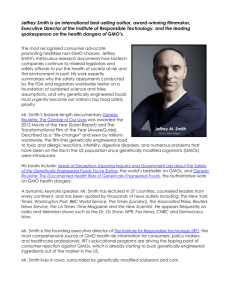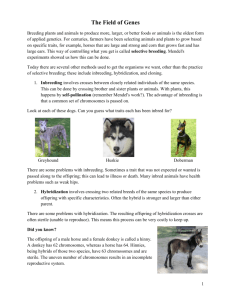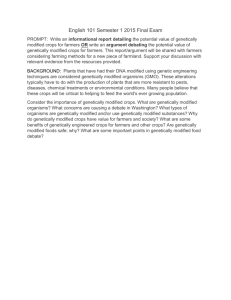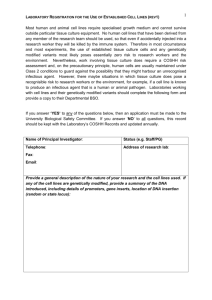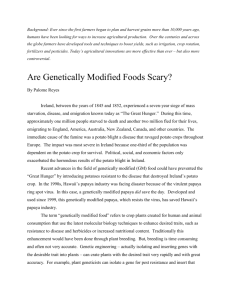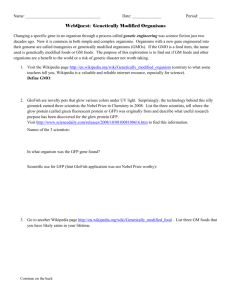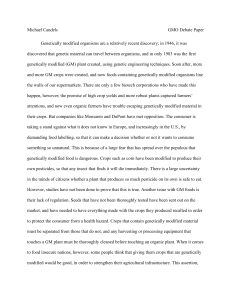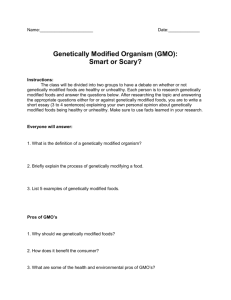The Right to Decide What We Eat
advertisement
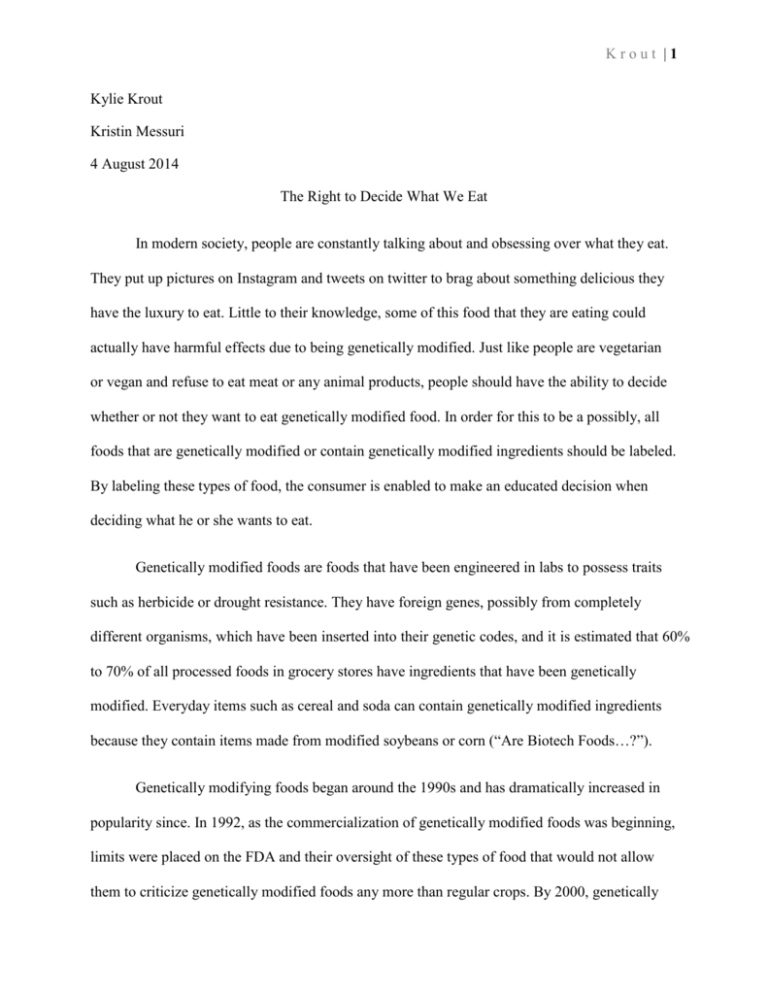
Krout |1 Kylie Krout Kristin Messuri 4 August 2014 The Right to Decide What We Eat In modern society, people are constantly talking about and obsessing over what they eat. They put up pictures on Instagram and tweets on twitter to brag about something delicious they have the luxury to eat. Little to their knowledge, some of this food that they are eating could actually have harmful effects due to being genetically modified. Just like people are vegetarian or vegan and refuse to eat meat or any animal products, people should have the ability to decide whether or not they want to eat genetically modified food. In order for this to be a possibly, all foods that are genetically modified or contain genetically modified ingredients should be labeled. By labeling these types of food, the consumer is enabled to make an educated decision when deciding what he or she wants to eat. Genetically modified foods are foods that have been engineered in labs to possess traits such as herbicide or drought resistance. They have foreign genes, possibly from completely different organisms, which have been inserted into their genetic codes, and it is estimated that 60% to 70% of all processed foods in grocery stores have ingredients that have been genetically modified. Everyday items such as cereal and soda can contain genetically modified ingredients because they contain items made from modified soybeans or corn (“Are Biotech Foods…?”). Genetically modifying foods began around the 1990s and has dramatically increased in popularity since. In 1992, as the commercialization of genetically modified foods was beginning, limits were placed on the FDA and their oversight of these types of food that would not allow them to criticize genetically modified foods any more than regular crops. By 2000, genetically Krout |2 engineered crops were being grown on 109.2 million acres in 13 different countries, with 68% of that amount being grown in the United States. Europe, who was initially open to the idea of genetically engineered foods, became skeptical of the large corporations and the effects of their products. This led them to adopt the Cartagena Protocol in 2000 that would not allow the technology to be approved until it was proven to definitely be safe (McLure). Although many developed countries are skeptical of genetically modified food, they are becoming increasingly popular and helpful in undeveloped nations. Not only can these crops produce a better yield and have a higher drought tolerance, they can also be modified to be more nutritious. These crops can be modified to be pest resistant, resulting in less crop loss from insects and eliminating the need for pesticides, which can also be hazardous. In addition, third world countries do not always have the best environments for growing crops, so farmers are forced to grow in areas that are not ideal. These types of crops can withstand the long periods of drought or high salt content in the soil. Lastly, these crops can help third world countries by possibly providing better nutrition. Since people in these countries usually have one crop as the main staple of their diet, that crop can be engineered to have more nutrients. For example, many countries rely on rice as the main part of their diet. Since rice does not contain adequate amounts of all the necessary nutrients, scientists have engineered a strain that has higher levels of vitamin A, which would help in solving blindness caused by vitamin A deficiencies (Whitman). Genetically modified foods have many benefits in developed countries as well. Other than being more nutritious, they can produce tastier food with a decreased used of pesticides. The food supply can be increased and have a longer shelf life so less food has to be thrown away due to expiring. These foods can also be faster growing; have more desirable traits, such as Krout |3 potatoes that absorb less fat when fried; and serve medicinal purposes, such as being used as vaccines or producing medicine (“Genetically engineered foods”) Although genetically modified foods seem to serve many purposes and can have great benefits, the risks of them remain largely unknown. These modified plans are not naturally occurring in the environment, and they may have genetic changes that are unexpected. These crops can also interbreed with natural organisms or take over entirely, causing extinction of the original crop(“Genetically engineered foods”). For example, my father grows genetically modified soybeans on his farm that are herbicide resistant. Once the crops have started growing, he will spray the entire field with round up, killing everything except the soybeans. He’s been doing this for a couple of years, and recently he has noticed that even after he sprays the field, some weeds, specifically mare’s tail, still survive. By using these genetically modified crops and spraying his fields, he has selected for the weeds that have the ability to survive being sprayed. Once those weeds pollinate, the next generation is all resistant to spraying. Because of this, my dad, and many other farmers, will be forced to take drastic measures to kill these weeds, such as using the herbicide 2,4-D. This herbicide is categorized as “moderately hazardous,” and is two steps more toxic than Roundup, according to the World Health Organization. This substance, which tried to be phased out, was used in Agent Orange during the Vietnam War, and was seen to have caused health problems such as cancer and birth defects (McLure). Genetically modified foods can also have direct health consequences which should immediately require them to be labeled. In several animal studies, The American Academy of Environmental Medicine found that genetically modified food caused infertility, immune problems, accelerated aging, faulty insulin rejection, and changes to major organs, including the gastrointestinal system. In addition to these problems, genetically modified foods have been Krout |4 linked to allergic reactions. For example, once genetically modified soy was introduced to the United Kingdom, soy allergies increased by 50 percent, and cooked genetically modified soy contains up to seven times the amount of a soy allergen. One of the most shocking studies, though, found that a substance called Bt, which is found in herbicide resistant crops and designed to be more toxic than herbicides, was found in the blood of women and fetuses (“Genetically Modified Foods…”). The facts about genetically modified foods are alarming, yet the Food and Drug Administration (FDA) has done little to regulate them. In the 1990s, FDA scientists warned of possible allergies, toxins, and nutritional problems with these kinds of food, and they urged more safety studies be done. Michael Taylor, Monsanto’s former attorney and the FDA official in charge of the policy, did not take the advice (“Genetically Modified Foods…”). Since then, the FDA has done nothing to regulate genetically modified foods or warn the public of their possible consequences, yet Monsanto, Dupont Pioneer, Cargill, and other producers of genetically modified food have spent over $25 million to stop statewide initiatives to label these types of food (McLure). Because the affects of genetically modified foods have been tested and the results show that they could be harmful, all foods with genetically modified ingredients should be labeled. A simple one inch by one inch label placed on the front of a package informing the consumer of what they are buying would be sufficient. It would cost little to nothing of the manufacturer, and take very little time to design packaging that would incorporate the label. All the FDA would need to do is pass legislation requiring it. They need to stop falling prey to the lobbyists of genetically modified food manufactures and do what is right for the well-being of Americans. Krout |5 As of now, it would be nearly impossible to stop using genetically modified foods altogether, and therefore, we should simply warn people that what they are purchasing may be harmful. With such dangerous consequences of using genetically modified crops, people should have a right to know what they are eating. Rather than having to wonder if a food product contains genetically modified ingredients, consumers should know exactly what kind of food they are eating. Although producers of genetically modified foods disagree with this measure because they would most likely lose sales, people should not be taken advantage of in this way. In order to be able to make informed, healthy choices, we as Americans need to contact our state representatives and address these concerns to better protect our families against the dangers of genetically modified foods. Krout |6 Works Cited "Are Biotech Foods Safe to Eat?" . WebMD, LLC., 1 Jan. 2014. Web. 30 July 2014. "Genetically engineered foods." . Medline Plus, 9 July 2014. Web. 30 July 2014. "Genetically Modified Foods Could Pose Numerous Health Risks." Genetic Engineering. Ed. Noël Merino. Detroit: Greenhaven Press, 2013. Opposing Viewpoints. Rpt. from "Doctors' Health Warning: Avoid Genetically Modified Foods." Vol. 1. 2011. Opposing Viewpoints in Context. Web. 30 July 2014. McLure, Jason. "Genetically Modified Food." CQ Researcher. 31 Aug. 2012: 717-40. Web. 30 July 2014. Whitman, Deborah. "Genetically Modified Foods: Harmful or Helpful?." . ProQuest, 1 Jan. 2013. Web. 30 July 2014.
